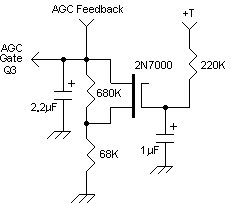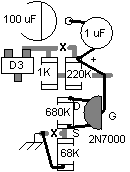
Rick Littlefield, K1BQT
The current problem with the stock Cub's receiver recovery occurs because the AGC loop is left partially charged after each CW character is sent. Because the Cub's AGC release time is (by necessity) slow, recovery on a quiet band seems correspondingly long on a quiet band.
My cure began by eliminating the AGC hang function that was used to reduce receiver sensitivity on transmit (see schematic below). I then installed a dual time constant in the AGC loop. This second, faster, time constant is activated by means of a FET switch controlled by the +T line. Its job is to force a "soft dump" of the AGC loop voltage after each transmitted dot or dash, while allowing the normal slow AGC release on received signals. When adding the switch, I found it necessary to program a short hold onto the gate to allow time for the receiver's antenna line to fully damp out before the AGC dump is removed. Without this sequencing, the AGC still had a tendency to pick up T/R transients and partially defeat the modification.


The modification configures the Cub's AGC for dual recovery time. To achieve this, cut the ground trace on the 680K AGC timing resistor and add a 68K resistor in series to ground (see pictorial at right). Next, tack-solder a 2N7000 FET across the existing 680K SMD timing resistor (R12). This configures the AGC loop so that when the 2N7000 is in conduction (gate high), the 680K resistor is bypassed and release time is fast. When the FET is open, release time is normally slow.
To provide a control circuit for the 2N7000 gate, cut the trace connecting the rear pad of R30 with the rear pad of R13. Remove the 4.7K resistor at R30 and replace it with 220K. Next, install a 1µF cap from the rear pad of R30 to ground using the eyelet to the right of C34. Finally, connect the 2N7000 gate lead to the rear pad of R30. This RC combination (220K and 1 µF) provides a sequencing delay to hold the gate high momentarily after +T is removed.
How good is the QSK with this modification? Think "Meg Ryan in a Restaurant" (actually, that may be overstating the case)! It will, however, cure the slow recovery problem and make your little Cub act like one of the QSK big kids. Key up, full background noise or incoming signal. Key down, comfortable sidetone. Only regret? I shoulda done it this way the first time!
1 – 2N7000 FET
1 – 1 µF electrolytic
1 – 68K resistor
1 – 220K resistor